
In this issue we focus on new stirrings: of light but also of initiatives, of travels to new continents, of new programs and courses for the coming summer months, of sales and new philanthropic targets.
“Lights . . . camera . . . .”
Douglas Gerwin, Director
Center for Anthroposophy
In this Issue
Dateline Punxsutawney, PA: The Significance of Groundhog Day for High Schools
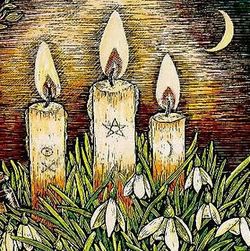
According to a medieval legend imported by German settlers to this town in Western Pennsylvania, the presence or absence of sunshine on February 2nd foretells the length of winter remaining. In the American version of this ritual, if the groundhog pops out of its hole and sees its shadow on this day, the remainder of winter will be long and cold; if it does not, winter is on its way out. Though it may sound counter-intuitive, a sunny day on February 2nd means lingering cold, according to this tradition; a cloudy day presages an early spring.
In the Christian calendar, this date is known as Candlemas, a lesser-known holiday celebrated 40 days after Christmas that marks the exact mid-point between the Winter Solstice and the Spring Equinox.

Candidates for this program––which this year starts on Sunday 1 July and runs through Saturday 28 July––can apply online at www.centerforanthroposophy.org or by contacting the Center at (603) 654-2566. Detailed syllabi of these specialized courses for high school teachers are also available at this site. Applications are processed during the months of February and March, regardless of the weather.
Dateline Wilton, NH: Lighten Up!

Basements, often dark and damp, are generally not the best place to store books and journals, especially if the space is old.
As it happens, the building owned by the Center for Anthroposophy is the oldest structure on Main Street, Wilton, having survived two rapacious fires that swept through the town during the 1800s. In fact, during the early days of the town, this four-story brick building served as the town hall; to this day the basement boasts two tiny jail cells. In more recent years, the building has housed an arts supply store, which the Center acquired and completely renovated when it bought the building in 2008.
Since the basement is a walk-out structure, with three walls above ground, it has turned out––contrary to expectations––to be an ideal home for the Cadmus Library, a collection of rare anthroposophical books and magazines.
To prepare this home, the Center, with help from the Cadmus Corporation, renovated a large portion of the basement as a reading room and library, putting in new wooden flooring, heating, and lighting, along with new shelves and furniture. The reading room not only houses the collection but also serves as meeting place and studio for artistic workshops for local children and seminars for students in the Waldorf program at Antioch University New England. In addition, thanks to a grant from the Cadmus Corporation, the Library recently acquired a new laptop computer, which can be linked for research to the Internet through the building’s Wi-Fi signal.
Although the basement was designed with a single window overlooking the Souhegan River at the back of the building, the fact remained that the space felt a little dark. This has now been remedied by the installation of a new window cut into a side wall facing the neighbors.
To be sure, the new window does not offer any scenic vistas, but the play of light coming in from a second outside source has made the room feel much brighter and more connected to the outside world. It has become all the more inviting as a place for meeting, studying, and conducting workshops.
The lesson to this story? What a difference an extra source of light can make!
Dateline Wilton, NH: Artists Young and Younger
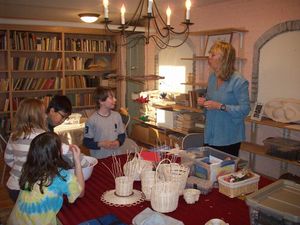
In recent months, Elizabeth Auer, a veteran arts and class teacher at Pine Hill Waldorf School, has been offering an after-school arts and crafts program three times a week for children aged 8-13 in the Cadmus Library Room below the Color Shop & More.
Activities have included embroidery, needle felting, mosaics, book binding, and basketry. Under Elizabeth’s expert eye, children from five local schools have been free to work on projects of their own choosing, sharing with each other in a relaxed, informal atmosphere of friendship and camaraderie. Occasionally parents have also joined in with a project of their own.
Elizabeth, who recently earned her M.Ed. from the Waldorf program at Antioch University New England, is currently on sabbatical after completing an eight-year journey with her class at the Pine Hill, where she also led Extra Lesson classes as well as teaching wood, stone, metal, and glasswork. She specializes in both watercolor painting for young children and scratchboard art. Her latest book, Creative Pathways, which contains most of the projects she created with her class over the eight years, will be published by AWSNA this year.
Elizabeth currently works as a freelancer, mentoring teachers, holding workshops in a variety of arts, as well as teaching drawing and handwork classes at Antioch New England University. For many years she has offered courses in the Renewal and Foundation Studies programs sponsored by the Center. She is scheduled to lead several artistic workshops during both weeks of this summer’s Renewal Courses in Wilton.
Dateline Wilton, NH: When Sound Becomes Song

High up in the architrave of the west entrance to the Cathedral at Santiago de Compostela sit two carved musicians with an ancient stringed organistrum (ancestor to the popular hurdy-gurdy) carefully balanced across their knees. As one can see from the photograph, this intricate instrument requires two players: one who turns the crank to elicit a bass drone, the other who operates the stops to fashion a strummed melody.
If one contemplates this carved pair of musicians––set as keystone in an arc of 24 elders spanning the tympanum of the Portico de Gloria––one will recognize in them the essential gesture of adult education: two players who between them fashion something that neither can accomplish alone. Only through their joint participation can this instrument give rise to the art of music.
So is it likewise with the preparation of teachers. Here again, only the collaboration of teachers––both seasoned and fresh––makes possible the art of teacher education.
The image of two musicians collaborating on a single instrument also captures the relationship between the Center for Anthroposophy and its circle of donors. Each year, through the Annual Giving appeal, the Center relies upon the renewed generosity of donors in order to practice the art of education in its summer and year-round programs of Foundation Studies, high school teacher education, and Renewal Courses.
Last year a record number––including 100% of trustees and core faculty––contributed to this campaign, which is dedicated primarily to the Georg Locher Scholarship Fund for Waldorf teachers. Among the contributors, a third were first-time participants, and over half of repeat donors increased their gift.
For every dollar the Center receives in scholarship funds, it is able to secure on average an additional six dollars from other sources. That means each gift has the potential to increase its value six-fold once the Center has received it.
At this writing, we have already exceeded last year’s target and received around 85% towards this year’s goal of $40,000, thanks to gifts of all sizes from a growing circle of donors. The appeal was also helped this year by the dedicated efforts of a newly formed development group, mandated by the Center’s Board of Trustees, and by the expertise of Boston Color Graphics, a company specializing in the design of annual appeals for non-profit organizations.
Can you help us close the remaining gap of about $5,000 so that we meet this year’s target? All contributions are tax deductible to the full extend allowed by law. Thank you.
Dateline Amherst, MA: Teachers as Farmers of Soul and Spirit
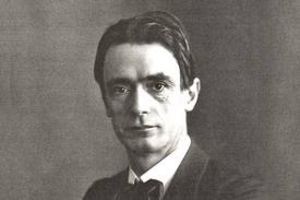
The Soul and Substance of Teacher Education
In college, my favorite professor was a barrel-chested giant of a man with a rough chiseled face, booming voice, and a voluminous nose that reminded me of Jimmy Durante’s celebrated schnozzle. A professor of philosophy, this teacher usually lectured without notes, though on occasion he would reach into a faded leather satchel to pull out some classic text such as Rene Descartes’ Discourse on Method, a treatise he was especially fond of dissecting.
More striking, though, than this man’s facial or vocal attributes were his huge angular hands, leathery as his worn satchel. So strong and vibrant were these hands that their gestures could give almost physical outline to the most metaphysical of concepts. Indeed, one might expect these hands to belong more to a woodsman or farmer than to a college professor.
And indeed this professor was a farmer –– a sheep farmer, to be precise. Though I would not have thought it at the time, looking back I will now venture that the secret to the sculptural energy and verve of his philosophical explanations had something to do with his agricultural practice.
There was another unusual feature to this man. In the course of a long career, he had published virtually nothing. And yet over the years he had risen through the ranks of a top-level English university to become Chairman of the Philosophy Department. Since academic advancement usually hinges on an ever-lengthening string of publications, the appointment of an essentially unpublished professor as head of department could only underscore his abilities as an extraordinarily vibrant thinker and compelling teacher.
Indeed, there may be something of a pattern here. To put it simply: some of my best teachers have been among the least published. This is not to dismiss many fine teachers I have had who boast impressive lists of publications, nor to ignore some lackluster teachers who never published a thing. But there is something special about a true teacher that simply eludes––even eclipses––the published scholar.
What is this special “something”? On the one hand, it is tempting to say that a teacher is born with this “something”, rather like musicians who are born with perfect pitch. And yet there is more. Whether it forms part of a freely chosen destiny or is received as an inherited gift (think only how many teachers, like musicians, are born into families of their eventual profession), this “something” needs to be practiced as a disciplined art. In other words teaching, like any art, requires continuously to be developed and enhanced. Herein lies the crucial need that teachers, however gifted and dynamic they may be as educators, submit their talents to the discipline of training and also the ceaseless pursuit of further professional development and renewal. In that sense Art, including the art of teaching, is much more about rehearsal than about performance.
In a cycle of lectures given not to teachers but a group of young people three years after the founding of the first Waldorf school in 1919, Rudolf Steiner sets out the crucial role of artistic practice in the vocation of teaching. “Every human being is a teacher, but he is sleeping and must be awakened,” he says, “and Art is the awakener.” A good teacher “does not depend on the giving out of knowledge but on activating the individuality of the soul, upon the pre-earthly existence. Then it is really the child who educates himself through us.” To activate the inner nature of the child, in other words, requires an artistic encounter. “We only educate when we behave in such a way”––that is, in an artistic way––“that through our own behavior the child can educate himself.”
Now, there is something as unusual about becoming a Waldorf teacher as there is about becoming an unpublished chairman of a philosophy department. In readying the inaugural circle of 12 men and women who constituted the first Waldorf faculty on the Uhlandshoehe of Stuttgart, Rudolf Steiner made it clear through his expectations and actions that the preparation of teachers must proceed at three levels. These can be summarized as:
a) Undertaking rigorous self development
b) Studying the human being in its archetypal stages of development
c) Practicing what I will call “the craft of teaching”
For those early teachers, these three levels constituted a hierarchy of training. By “hierarchy” I mean they entailed an order of priority by which they were to be taken up. To explore briefly each level:
a) In becoming a Waldorf teacher, self development comes first and remains primary for the duration of one’s career. As Steiner put it to the teachers in Stuttgart, “the more we think of leading a right and proper life ourselves, the better will it be for the child . . . . For you can only become good teachers and educators if you pay attention not merely to what you do, but also to what you are.”
Ultimately, the purpose of any schooling is to help each child go through a process of self-transformation. By definition, of course, “self-transformation” can be practiced only by––and on––one’s self. That said, a child needs to be guided in this process, but only by adults who continuously practice it on themselves. As Aristotle would put it, “All learning proceeds by mimesis.”
Even teenagers––who, in the end, learn only by the exercise of their own judgment––will imitate their teachers: not, of course, their outer behavior (which may very well be the object of teenage mockery) but rather their inner striving.
b) Study of human development. This can take many forms and involve many of Steiner’s writings. Perhaps best known among them is the lecture cycle quoted above and familiar to Waldorf teachers as Allgemeine Menschenkunde (in English called Study of Man: General Education Course but more precisely translated as “General Study of the Human Being”), which Steiner gave over a period of two weeks to the first Waldorf teachers shortly before the opening of the Stuttgart school. In many other lecture cycles and books, however, he paints sweeping archetypal pictures of the human being––two-fold, three-fold, four-fold, seven-fold, twelve-fold, and more––in its unfolding from earliest beginnings to furthest future. Here is invitation to a lifetime of study!
c) Finally, in light of these first two levels, and only in this light, comes the craft of teaching, which embraces all that has to do with curriculum, teaching techniques, organization of the classroom, relations with colleagues and parents, and the role in education of the world at large. Whatever is gained at this third level will be of lasting value only to the degree it is saturated with a profound understanding of the archetypal human being, and the study of the human being in its archetypal nature presupposes a rigorous and disciplined program self-development. Hence the hierarchy of these three levels.
Before we consider how one might undertake the preparation of teachers at these three levels, it is worth a noting that this approach represents a direct inversion of what normally passes for teacher training in the wider circles of education. Step outside the world of Waldorf education, and you will find that much of teacher training is devoted to Level Three, or “the craft of teaching”: what to teach, how to teach it, how to manage the children, how to keep up with the expectations of the educational institution that provides your salary, and so on. Maybe along the way some time is devoted in teacher training to Level Two in the form of a seminar on theories of child development––a little Piaget, perhaps a few others––though in some programs the very notion of predictable, developmental stages in the unfolding of the child is held in doubt. (In the halls of teacher education, I was surprised to learn, the idea of child development as a process of transformation, as opposed simply to being a process of maturation involving no radical metamorphosis, is still treated as an “alternative” or minority view.) As for prospective teachers being expected to undertake Level One, or self-development, they may well be told, “That is a private matter and should not form part of any certified teacher training.”
Given the inversion of these three stages in Waldorf teacher training, it remains to be described how each of these is attempted. To be sure, the ways are many, and I speak only out of the approach pursued in the high school and elementary teacher training programs sponsored by the Center for Anthroposophy and Antioch University. And yet I believe any full-dress program for prospective Waldorf teachers will share the essentials of this approach.
First, self development. Rudolf Steiner offered all manner of exercises and indications in this regard, from the initial so-called six “basic” (sometimes called “supplementary”) exercises for any student of anthroposophy to verses specifically for teachers. But perhaps some of the most powerful stimuli to self-development arise from a disciplined practice of the arts, especially those most closely associated with the Waldorf curriculum such as eurythmy, speech, veil painting, sculpture, and spacial dynamics. That is why fully 50% of teacher training, as we undertake it, is spent in the practice––at times painful and frustrating, at other times liberating and rejuvenating––of the arts. The primary purpose here is not to train teachers to become artists or teachers of art (though these may be necessary skills, especially for teachers in the elementary grades) but rather to tap those fonts of creative imagination that can give rise to genuine and lasting metamorphosis of self as well as a profound encounter between teacher and student. In the artistic encounter we discern the true individuality of the other. And discernment of one’s essential individuality––in the student by the teacher; in the teacher by the student––lies at the fundament of education.
Then, study of human development. Again, Steiner provides countless entryways into this arena, either through his so-called basic books or through any number of lecture cycles and practical courses. Beyond the study of these, however, prospective Waldorf teachers take up “biography work”, in which they come to a more intimate understanding of the general phases of human development by mapping the phases of their own. Here too a disciplined practice of the arts as a path of self-discovery can help immensely to get teachers beyond the dizzying array of their own biographical data to educe the essential––and often undiscovered––streams weaving through them.
Finally, the craft of teaching. Like the previous two levels, practice at this level continues indefinitely, even though along the way teachers may earn a certificate that bespeaks a certain level of competence. Ultimately, though, craft means practice, and practice means regular and disciplined time in the studio, which for the teacher is the classroom. Some teacher training programs emphasize this aspect of the training more than others. Generally I find that the longer the internship or practicum in the classroom, the greater the success of the teacher post-training.
* * * * * * * *
Ultimately, as the Ancient Greeks knew long ago and as modern empirical science is demonstrating anew, the pathway to changing the workings of the body resides in changing the activities practiced by the spirit. And the route to changing the work of the spirit resides in changing the practices of the body. Think only of recent studies in neuroscience that demonstrate the degree to which our thoughts give rise to the structures of our brain (not the other way around) and how changes in diet and exercise give rise to changes in our mental and emotional states.
In other words, as Waldorf teachers, we are agents of change––first in ourselves, then in the children entrusted to our care––to the degree we work on soul and spirit to effect changes in soil and substance, and vice versa.
The implication is that to be teachers, we need to be farmers, too.
Dateline Asheville, NC: Students Reflect on their Foundation Studies
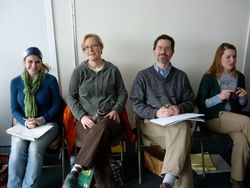
Asheville Foundation Studies cluster in North Carolina finished its two-year program in November 2011. The group would like to start another cluster there in the next couple of years.
Among the evaluations we received from participants came this note from Shalene Wyrick: “My life was changed, transformed, and brought full circle in many ways due to my involvement with and study of anthroposophy. I helped to start a Waldorf (inspired) school here in Asheville and have aspirations of continuing training in Spacial Dynamics and singing. I feel like I am just getting started!”
Another student in this program, Angela Foster, wrote: “My experience of every session in Asheville has been spot-on. Each and every presenter has been very good. I had no idea (consciously) what I was getting into. I feel so blessed to have begun to open this door in my life. I am so grateful that this program exists in the world.” Angela is now the local coordinator for the Center’s Foundation Studies cluster in Atlanta, GA, which she is attending as a second-go-around student, this time with her husband.
Looking ahead to the 2012-2103 season, clusters are already forming in Charlottesville VA and Washington DC, as well as possibilities in Cape Ann MA, Cincinnati OH, Clearwater FL, and Wilton NH. Stay tuned to these pages––or to our website––for details.
Dateline Kyle, ND: Can You Count the Paths Leading to Waldorf?
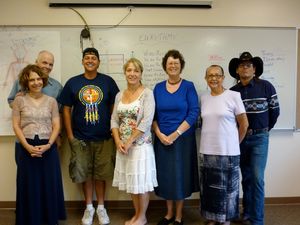
For the past couple of years, I have been guiding a small group of Native American teachers in Eurythmy as part of the work they are doing with in child development, art, and the reading of Study of Man by Rudolf Steiner with Patrice Maynard from the AWSNA leadership and Laurie and Tom Clark from the Denver Waldorf School.
As life would have it, a prospective student in the Waldorf program at Antioch University New England (several thousand miles away) happens to live in South Dakota, a “mere” four hours away from Kyle. For years she was intrigued by the Waldorf school that her younger sister once visited. This fall, while attending a Head Start workshop in Kyle, she saw a sign by the side of the road––“Lakota Waldorf School”––and her memories of Waldorf and her previous reading of How to Know Higher Worlds by Rudolf Steiner all came alive for her.
She is now interested in becoming a Waldorf teacher and plans to join this group at Lakota Waldorf School in April in order to get a wider and deeper experience. She will undertake CfA’s Individual Mentoring Program in Foundation Studies as well as some group work while she prepares to matriculate into the Antioch program.
Dateline Freeport, ME: Planets in Gesture and in Word
As part of their second-year program, participants in the cluster of Foundation Studies at the Merriconeag Waldorf School explored the gestures of the planets in eurythmy and in poetry. Kristin Agudelo, a graduate of this program and newly enrolled member of the Center’s high school teacher education program, submitted these samples of Haiku:
MARS
Move it!
Take what you have inside
And thrust it
Into the wide world beyond.
VENUS
She dips and turns
Rolling side to side
Like the smooth lemniscate
of her hips.
SUN
Round the ferris wheel of the mind
rides Fear.
Then at the top–
ah!
A breath of airy light.
Dateline Wilton, NH: Spring Around the Corner and On the Shelves of the Color Shop & More

Winter speeds by faster if you can curl up with a good book –– either for yourself or to share with children. With an eye on the coming season, the Color Shop & More is filling its shelves with a new line of beautifully illustrated children’s books, along with an array of flying machines, origami sets, puzzles, and kits for all ages. In one corner of the store a veritable toy farmyard is springing up with imported Easter bunnies, soft lambs, furry mice, and a charming set of ducklings.
For adults, the store has acquired a new selection of recently published books on Waldorf education and anthroposophy, including texts used in the Center’s foundation studies and teacher education programs.
The store has also restocked its arts supplies with new materials including a new line of high-quality paint brushes.
Winter hours for the store are Tuesday-Friday from 11:00 a.m. to around 5:00 p.m. and Saturday from 10:00 a.m. to 4:30 p.m. For placing orders, contact the staff at (603) 654-6297 or via e-mail at info@colorshopandmore.com.
Dateline Wilton, NH: Renewal Course Listings for Summer 2012
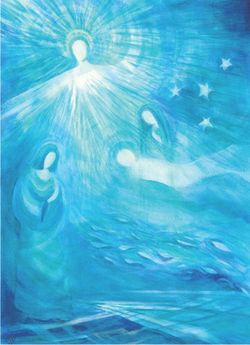
Dear Friends,
We come together to nurture a living thinking that is active and full of compassion –– a thinking that draws us ever closer by firing the heart and harnessing the will. Once again we will spend two brief summer weeks together taking hold of new seeds for planting in an old world. Anthroposophy grows both through the vibrant spiritual forces of the individual and through the recognition we bestow upon one another.
Welcome to Renewal 2012! We hope to embrace you, inspire you, and warm you with good company and great food as we share in a feast of rich courses during the day and joyous evenings of lectures, music, and dance.
Here are courses for Waldorf teachers––both new and experienced––along with parents, administrators, trustees, and friends of Waldorf education, as well as for artists and thinkers seeking to deepen their lives through anthroposophy.
As in previous years, we will gather––for this, our 13th summer––on the beautiful campus of High Mowing School in the company of a remarkable roster of teachers. Take a moment to browse through this booklet for a course that might speak to your particular interests or needs.
Be sure to sign up early, so that we can secure our courses and plan our activities with your interests in mind and heart.
Looking forward to welcoming you (back)!
This is a taste of what last year looked like >
Week I of Renewal starts Sunday 24 June and ends Friday 29 June
Week II of Renewal starts Sunday 1 July and ends Friday 6 July



